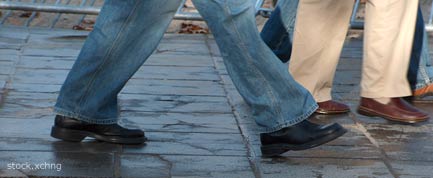Why Humans Walk 'Flat-Footed'

Cats and dogs trot around on their toes, as do many other mammals. So why do humans and other great apes walk flat-footed? It is surprisingly energy efficient, a new study suggests.
It takes 53 percent more energy for humans to walk on the balls of their feet, and 83 percent more energy to toe-walk.
However, the energy savings don’t apply to running. There's no difference, energy-wise, between landing on our heels and landing on the balls of our feet when we run, the scientists say.
They speculate that humans may have retained this heel-first gait because of the walking benefits.
"Our ancestors were hunter gatherers, so anything that improved walking would make a lot of sense to hang on to," said study-author David Carrier of the University of Utah.
Were we really "born to run?"
Humans have exceptional aerobic stamina compared with other animals, and other characteristics, like our ability to sweat easily, seem catered to running long distances. Yet unlike other animals that are specialized for running, we have "flat feet": Our heels touch the ground first when walking, known as a plantigrade foot posture.
Get the world’s most fascinating discoveries delivered straight to your inbox.
"If you think about the animals that are the best runners, they're animals that tend to run around on the balls of their feet like cats and dogs," Carrier said.
Carrier’s team had 40 participants run and walk on treadmills using different gaits while the researchers measured their oxygen use. Among the findings:
- Heel-first walking is more efficient than toe-first at transferring stored energy into motion, so our muscles don't have to do as much work.
- With each step, some energy of motion is lost when your feet hit the ground. When you walk on the balls of your feet, you lose about 16 to 17 percent more energy due to these "collision forces" than you do if you walk heel-first.
- Toe-walking requires activation of certain calf muscles that don't need to be used in heel-first walking, as your weight is directly supported by your heel.
The researchers found no difference between heel-first running and running on the balls of your feet in terms of energetics. However, those accustomed to toe-first running may get an energy savings, but it's likely not much, Carrier said.
Adaptation?
"It looks like having this foot posture, this more plantigrade foot posture, sort of gives us the best of both worlds, where we have lower energy costs of walking and it doesn’t really impact our running energy costs at all," said David Raichlen, a professor at the University of Arizona who studies the energetics of primate walking and running, and who was not involved in the study.
But nobody knows why plantigrade feet originally evolved in great apes.
"The thing about great apes is that they're not great walkers, they don't walk long distances," Carrier said. So walking probably wasn't the reason this foot posture originally came about in our ancestors, although it makes sense for walking in humans, he said.
The results were published online today in the Journal of Experimental Biology.

Rachael is a Live Science contributor, and was a former channel editor and senior writer for Live Science between 2010 and 2022. She has a master's degree in journalism from New York University's Science, Health and Environmental Reporting Program. She also holds a B.S. in molecular biology and an M.S. in biology from the University of California, San Diego. Her work has appeared in Scienceline, The Washington Post and Scientific American.


